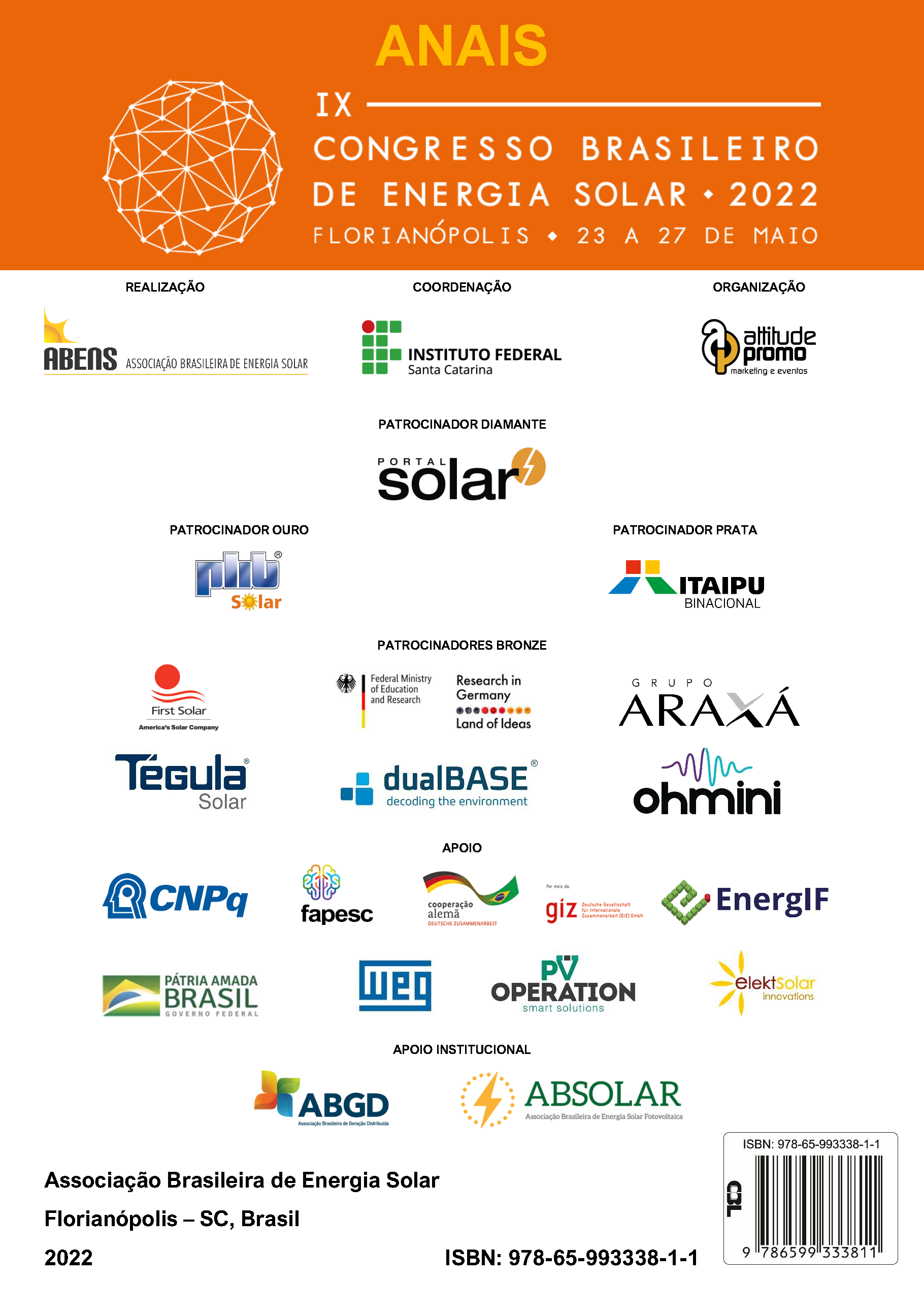ANÁLISE DA CAPACIDADE ENERGÉTICA MEDIDA EM UM SISTEMA DE ARMAZENAMENTO DE GRANDE PORTE EM DIFERENTES NÍVEIS DE POTÊNCIA
DOI:
https://doi.org/10.59627/cbens.2022.1189Palavras-chave:
Armazenamento de energia elétrica, Capacidade Energética, Sistema de grande porteResumo
Esse artigo apresenta a análise de capacidade energética medida com diferentes níveis de potência para um sistema de armazenamento instalado em Capivari de Baixo – SC (28,45°S, 48,97°L), com capacidade nominal de 1000 kWh e 1000 kW, junto a uma usina solar fotovoltaica de 3 MWp e uma usina eólica de 6,9 MW. O teste de capacidade realizado comum terço da potência nominal resultou em uma capacidade energética de 839,1 kWh, com uma temperatura máxima de operação de 24,44 ºC. Para o teste com metade da potência nominal foi obtida uma capacidade energética de 835,38 kWh, com uma temperatura máxima de 24,78 ºC. Já para o teste em potência nominal, a capacidade energética resultante foi de 824,45kWh , com uma temperatura máxima de 27,60 ºC. O PCS tem uma margem de erro fixa relativa à sua potência nominal (1 MW), portanto o despacho de potência tem oscilação máxima de 13% para o despacho em ⅓C, 6% para o despacho em ½C, e 2% para 1C. O sistema auxiliar possui um autoconsumo mínimo de aproximadamente 180 kWh por dia, que corresponde a 20% da capacidade total de armazenamento de energia do BESS.
Downloads
Referências
ANEKE, Mathew et al. Energy storage technologies and real life applications – A state of the art review. Applied Energy, [s. l.], v. 179, n. 5, p. 350–377, 2016. Disponível em: https://doi.org/http://dx.doi.org/10.1016/j.apenergy.2016.06.097
CAMPOS, Rafael Antunes et al. The Role of Second Life Li-ion Batteries in Avoiding Generation Curtailment in Utility-scale Wind + Solar Parks in Brazil. Conference Record of the IEEE Photovoltaic Specialists Conference, [s. l.], p. 2078–2081, 2019. Disponível em: https://doi.org/10.1109/PVSC40753.2019.8980869
DAS, Trishna; KRISHNAN, Venkat; MCCALLEY, James D. Assessing the benefits and economics of bulk energy storage technologies in the power grid. Applied Energy, [s. l.], v. 139, p. 104–118, 2015. Disponível em: https://doi.org/10.1016/j.apenergy.2014.11.017
GUAN, Ting et al. The degradation of LiCoO2/graphite batteries at different rates. Electrochimica Acta, [s. l.], v. 279, p. 204–212, 2018. Disponível em: https://doi.org/10.1016/j.electacta.2018.04.197
JO, Hyeondeok; KIM, Chunghun; HAN, Sekyung. Performance Evaluation of BESS for Korean Power System Using Equivalent Power System Circuit Model. IFAC-PapersOnLine, [s. l.], v. 52, n. 4, p. 246–251, 2019. Disponível em: https://doi.org/10.1016/j.ifacol.2019.08.200
LUÍS, Alexandre et al. PANORAMA SOBRE TECNOLOGIAS DE ARMAZENAMENTO DE ENERGIA ATRAVÉS DE BATERIAS UTILIZANDO BASES PATENTÁRIAS. [s. l.], 2018.
MELENDEZ, Teddy A F et al. Geração distribuida com armazenamento conectada à rede elétrica. VII Congresso Brasileiro de Energia Solar, [s. l.], n. 2016, 2018.
PEEL, C. M.; FINLAYSON, B. L.; MCMAHON, T. A. Updated world map of the Köppen-Geiger climate classification. Hydrology and Earth System Sciences, [s. l.], v. 11, p. 1633–1644, 2007. Disponível em: https://doi.org/https://doi.org/10.5194/hess-11-1633-2007
RAMOS, Ariana; TUOVINEN, Markku; ALA-JUUSELA, Mia. Battery Energy Storage System (BESS) as a service in Finland: Business model and regulatory challenges. Journal of Energy Storage, [s. l.], v. 40, p. 102720, 2021. Disponível em: https://doi.org/10.1016/j.est.2021.102720
XU, Bin et al. Decoupling the thermal and non-thermal effects of discharge C-rate on the capacity fade of lithium-ion batteries. Journal of Power Sources, [s. l.], v. 510, p. 230390, 2021. Disponível em: https://doi.org/10.1016/j.jpowsour.2021.230390


